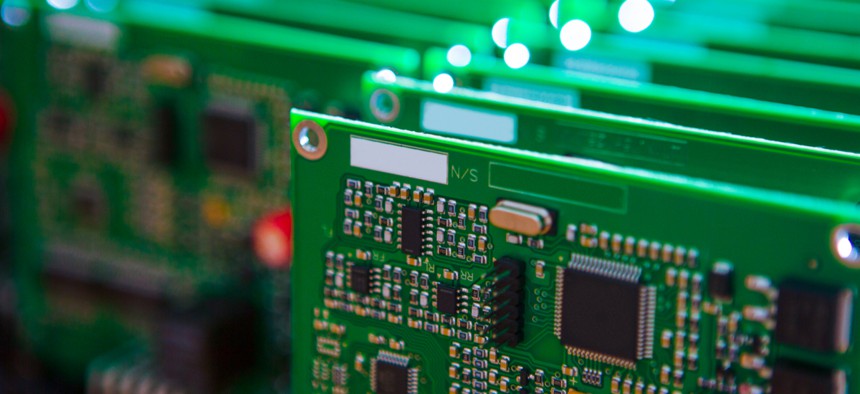Industry Groups Spar Over NDAA Provisions on Sourcing of Electronics from China

Dmitry Morgan/Shutterstock.com
Dueling letters to lawmakers support and oppose language requiring the department to phase out the procurement of some basic technology from adversarial nations.
Manufacturers and assemblers of printed circuit boards are standing apart from other major industry groups in praising sections of the National Defense Authorization Act that would require defense contractors to use less and less of such equipment from adversarial nations over time.
“For years, domestic industry has diminished in size and power while other countries, including China, have invested heavily in bolstering their own industrial capabilities,” reads a Sept. 29 letter IPC, a trade association of the manufacturers, sent to the chair and ranking members of the House and Senate Armed Services committees. “As a result, DoD today relies on nonallied producers for [printed circuit boards and printed circuit board assemblies] in areas including cloud servers, IT, and telecom networks. This continued reliance on untrusted foreign suppliers for [printed circuit boards and printed circuit board assemblies] poses numerous risks to national security.”
Both the House- and Senate-passed versions of the NDAA would require Defense contractors to use increasingly more of such equipment from U.S. manufacturers or those of allied countries. Under the House bill 100% of printed circuit boards and printed circuit board assemblies would come from those covered countries by 2033. The Senate bill calls for full sourcing from covered countries by 2032 and 25% of the equipment coming from trusted countries by 2023.
The Senate bill also explicitly bars procurement of the equipment from China, Russia, Iran and North Korea, all of which have been designated as posing world-wide threats by the intelligence community.
“We urge you to speedily resolve any remaining issues between the House and Senate while keeping in mind the strong protections that passed both chambers with overwhelming support and without any vocal opposition,” IPC wrote.
A conference committee which will reconcile the House and Senate bills before a final vote on the legislation has not yet been formed, staff from the office of Rep. Jim Langevin, D-R.I., chairman of an Armed Services subcommittee on emerging threats, told Nextgov.
The NDAA provisions—Sec. 808 in the Senate bill and Sec. 826 in the House bill—did spur opposition from a broader group of companies in advance of those negotiations.
“ARWG remains concerned with the broad applicability and programmatic impact of the House and Senate provisions related to printed circuit board (PCB) procurement,” reads a Sept. 24 letter the Acquisition Reform Working Group also sent to the leaders of the Armed Services Committees in both chambers.
ARWG includes the Associated General Contractors of America, the Information Technology Industry Council, the Computing Technology Industry Association, the National Defense Industrial Association, the American Council of Engineering Companies and the United States Chamber of Commerce.
“ARWG recommends the conferees direct the Secretary of Defense to implement a design verification standard to ensure that [printed circuit boards] present no national security risk regarding counterfeiting, quality, or unauthorized access,” the associations collectively wrote. “Subsequent to this submission, ARWG will provide specific recommendations on these matters separately.”
The House and Senate bills both contain a number of ways companies might receive waivers from the provisions from the Secretary of Defense, including if the secretary determines the covered equipment poses no significant national security concerns regarding counterfeiting, quality, or unauthorized access.
Chris Mitchell, IPC’s vice president for global government affairs told Nextgov the request for a design verification standard and the provisions in the NDAA bills are “not mutually exclusive,” noting “we should and have been working to develop standards along the lines of what’s laid out in the [ARWG] letter.”
He added that IPC separately has a trusted supplier standard—IPC 1791—that the group believes is a model for DOD. And he stressed that while the design verification standard has merit, it doesn’t fully address either the security issue or those of the resilience of the industrial base in general, with 55% of printed circuit board production happening in China.
A Sept. 16 blog post from IPC President John Mitchell asserts, “The opposition fears the new requirements will disrupt their established supply chains in countries that are not affirmatively covered.”
“The status quo may be advantageous to some, but this is not a compelling enough reason to nullify a major step forward for American manufacturing capabilities,” the IPC letter reads. “[the NDAA provisions] would create new high-skilled workforce opportunities for U.S. workers and provide trusted supplies to the U.S. government to use in critical applications.”
NEXT STORY: Post-election shutdown risk looms






